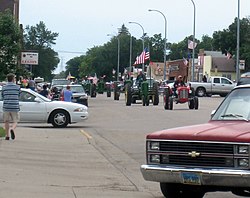Washburn, North Dakota | |
|---|---|
 2007 Tractor Trek traveling down Main Ave. in Washburn | |
| Motto(s): "The Grandest Little City on the Missouri-Washburn, North Dakota" | |
 | |
| Coordinates: 47°17′31″N101°01′40″W / 47.29194°N 101.02778°W | |
| Country | United States |
| State | North Dakota |
| County | McLean |
| Founded | 1882 |
| Government | |
| • Commission President | Larry Thomas |
| Area | |
• Total | 1.79 sq mi (4.63 km2) |
| • Land | 1.69 sq mi (4.36 km2) |
| • Water | 0.10 sq mi (0.27 km2) |
| Elevation | 1,831 ft (558 m) |
| Population | |
• Total | 1,300 |
| 1,289 | |
| • Density | 771.51/sq mi (297.96/km2) |
| Time zone | UTC-6 (Central (CST)) |
| • Summer (DST) | UTC-5 (CDT) |
| ZIP code | 58577 |
| Area code | 701 |
| FIPS code | 38-83700 |
| GNIS feature ID | 1036316 [2] |
| Highways | US 83, US 83 Bus., ND 200 Alt. |
| Website | washburnnd.com |
Washburn is a city in southern McLean County, North Dakota, United States. Located along the upper Missouri River, it is the county seat of McLean County. [5] The population was 1,300 at the 2020 census. [3]
Contents
- Geography
- Climate
- Demographics
- 2010 census
- 2000 census
- Notable people
- Climate 2
- Education
- References
- Further reading
- External links
Washburn was founded in 1882 near the former site of Fort Mandan, winter quarters of the Lewis and Clark Expedition in 1804–1805, near a Mandan village. The town was designated as the county seat in 1883. The city's name honors General Cadwallader C. Washburn. [6]
Washburn is home to the North Dakota Lewis and Clark Interpretive Center, which focuses on the Expedition's winter near the Mandan village. It houses a full-scale replica of Fort Mandan, which workers of the expedition built as their base, and one of the expedition's canoes.


